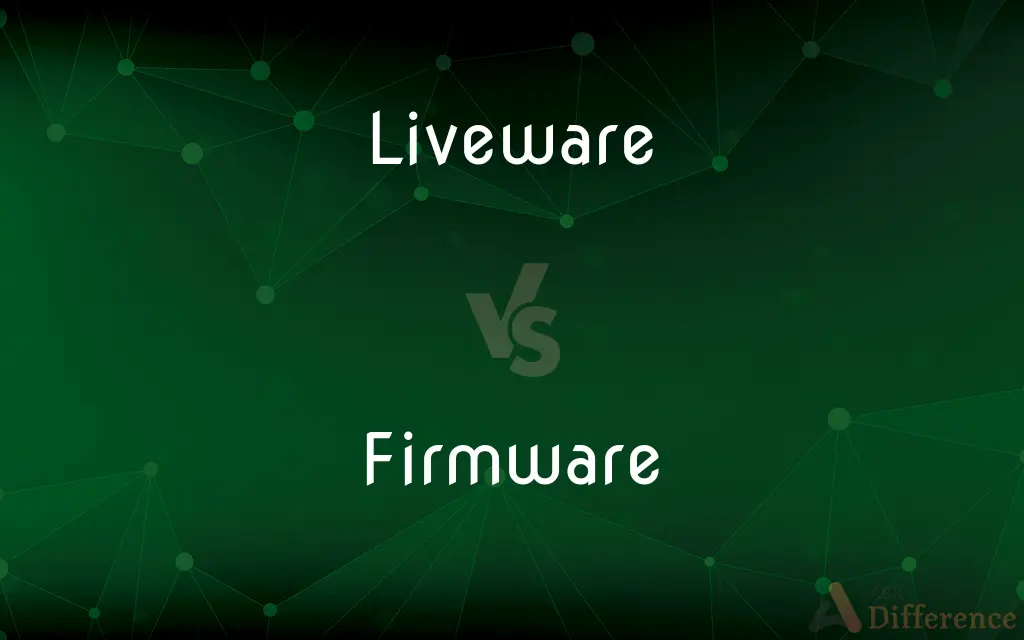Liveware vs. Firmware — What's the Difference?
Edited by Tayyaba Rehman — By Maham Liaqat — Updated on March 11, 2024
Liveware refers to human elements in computing systems, while firmware is embedded software controlling hardware.

Difference Between Liveware and Firmware
Table of Contents
ADVERTISEMENT
Key Differences
Liveware, representing the human aspect of computing systems, plays a crucial role in the operation and management of technology, emphasizing the importance of human interaction and adaptability. Firmware, on the other hand, is specialized software permanently embedded into hardware devices to control their functions, highlighting the interaction between software and physical components.
Liveware is characterized by its capacity for learning and adaptability, able to respond dynamically to varying situations and demands in computing environments. Whereas firmware, being pre-installed and integral to its hardware, offers a stable and consistent operating foundation, ensuring devices perform their designated tasks effectively.
The concept of liveware emphasizes the significance of human knowledge, creativity, and decision-making in the technological sphere, underscoring the value of human intelligence and problem-solving skills. Conversely, firmware underscores the importance of reliability and efficiency in hardware operation, with its fixed nature providing a dependable platform for device functionality.
Liveware's role involves interaction, maintenance, and improvement of technological systems, reflecting the ongoing development and evolution of computing technologies through human expertise. Firmware, in contrast, typically requires updates or modifications less frequently, reflecting a more static approach to device functionality and control.
The distinction between liveware and firmware highlights the dynamic versus static nature of their contributions to technology. Liveware's adaptability and growth potential contrast with firmware's consistency and embedded functionality, illustrating the complementary roles of human and software elements in computing.
ADVERTISEMENT
Comparison Chart
Definition
Human elements involved in computing systems.
Embedded software controlling hardware.
Role
Adaptable interaction and management of systems.
Provides stable control over hardware.
Characteristics
Learning ability, adaptability.
Stability, reliability.
Function
Enhances and manages technology through human expertise.
Ensures hardware operates as intended.
Update Frequency
Continuous learning and development.
Updates less frequently, mostly for fixes or improvements.
Compare with Definitions
Liveware
Human component in computer systems responsible for operation and management.
The IT department, as liveware, ensures the smooth operation of our computing infrastructure.
Firmware
Pre-installed software on hardware devices controlling their functions.
The printer's firmware facilitates communication between the computer and the device.
Liveware
Adapts and responds to changes in the computing environment.
The development team quickly adjusted the project scope in response to new requirements.
Firmware
Executes specific tasks designed for the hardware.
The camera's firmware processes images and operates the lens automatically.
Liveware
Integral for the creative and strategic use of technology.
Strategic decisions made by management significantly impact the company's technological direction.
Firmware
Ensures reliability and efficiency of hardware operations.
Firmware updates improve device security and functionality.
Liveware
Interfaces between technology and human needs.
User experience designers ensure that software meets the users' needs effectively.
Firmware
Embedded and typically only updated for enhancements or fixes.
Updating the router's firmware improved its performance and security.
Liveware
Liveware was used in the computer industry as early as 1966 to refer to computer users, often in humorous contexts, by analogy with hardware and software.It is a slang term used to denote people using (attached to) computers, and is based on the need for a human, or liveware, to operate the system using hardware and software. Other words meaning the same or similar to liveware include wetware, meatware and jellyware.
Firmware
Serves as an intermediary between the hardware and software applications.
The smartphone's firmware manages the charging process and battery management.
Liveware
(colloquial) People who work with computers, as opposed to the software or hardware they use; loosely, human beings, as opposed to technology.
Firmware
In computing, firmware is a specific class of computer software that provides the low-level control for a device's specific hardware. Firmware, such as the BIOS of a personal computer, may contain only elementary basic functions of a device and may only provide services to higher-level software.
Firmware
Software stored in a computer's ROM.
Firmware
(computing) Something in between hardware and software. Like software, it is created from source code, but it is closely tied to the hardware it runs on.
Firmware
Software intended for such embedded computer applications.
Firmware
(computer science) coded instructions that are stored permanently in read-only memory
Common Curiosities
Are liveware and firmware interchangeable?
No, they serve different purposes: liveware refers to human users and operators, while firmware is embedded software controlling hardware.
Can firmware be updated?
Yes, firmware can be updated to fix bugs, improve functionality, or add new features, though less frequently than software applications.
How do liveware and firmware interact?
Liveware interacts with firmware through the use of hardware devices, where firmware executes the commands and processes input from the user.
What is liveware?
Liveware refers to the human elements or users involved in computing systems, highlighting the importance of human interaction and intelligence in technology.
What is firmware?
Firmware is specialized software that is permanently embedded into hardware to control its functions, ensuring the device operates as intended.
Why is liveware important?
Liveware is crucial for the strategic, creative, and efficient use of technology, facilitating innovation and adapting to new challenges.
What role does firmware play in security?
Firmware plays a critical role in security by ensuring hardware integrity and can be updated to address vulnerabilities.
How can liveware affect technology development?
Liveware drives technology development through innovation, problem-solving, and adapting to new technological trends and demands.
Is firmware visible to the user?
Firmware operates in the background and is not directly interactable by the user, though its effects are evident through device functionality.
How does the update process differ between liveware and firmware?
Liveware continually evolves through learning and experience, while firmware is updated through specific software patches or releases.
What happens if firmware fails?
If firmware fails or becomes corrupted, it can cause the hardware to malfunction or stop working, requiring troubleshooting or replacement.
How does firmware impact device performance?
Firmware directly impacts device performance by controlling hardware operations, ensuring stability, efficiency, and reliability.
Do all hardware devices have firmware?
Most electronic devices have firmware, which provides low-level control over their functions.
Can firmware be considered software?
Yes, firmware is a type of software specifically designed to be permanently installed on hardware.
Why might firmware need to be updated?
Firmware may need updates for performance improvements, security patches, or adding new features to the hardware.
Share Your Discovery

Previous Comparison
Denial vs. Repression
Next Comparison
Muton vs. ReconAuthor Spotlight
Written by
Maham LiaqatEdited by
Tayyaba RehmanTayyaba Rehman is a distinguished writer, currently serving as a primary contributor to askdifference.com. As a researcher in semantics and etymology, Tayyaba's passion for the complexity of languages and their distinctions has found a perfect home on the platform. Tayyaba delves into the intricacies of language, distinguishing between commonly confused words and phrases, thereby providing clarity for readers worldwide.
















































